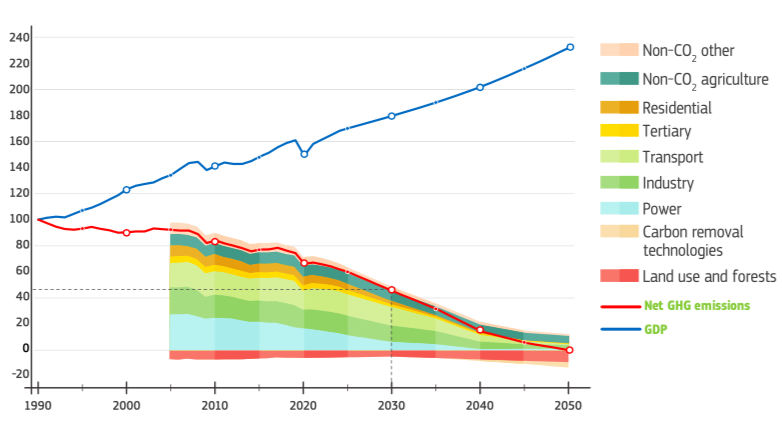18 Sep 2020 The European Commission has presented the new 2030 Climate Target Plan
The European Commission has published the new 2030 Climate Target Plan, proposing to raise to 55% the cut in GHG emissions by 2030. This more ambitious target for the next decade will put the EU on the right path to reach its goal of climate neutrality by 2050. A key role in this transition will be played by SMEs, which SVI is primarily working with to help them become more sustainable and to attract sustainable capital.
Based on a comprehensive impact assessment, on 17 September 2020, the European Union published a proposal to increase the EU’s target on reducing GHG emissions from 50% to 55% by 2030, compared to 1990 levels, setting in this way a more ambitious and cost-effective path in line with the goal of zero carbon emissions by 2050.
The impact assessment has proved that such an increase is feasible and that all sectors of the economy and society can contribute to reaching it. Moreover, according to the assessment, this increase can stimulate sustainable economic growth, the creation of green jobs, and accelerate the transition towards clean energy. More importantly, it can play a decisive role in the green recovery following the crisis brought by the Covid-19 pandemic.
In March 2020, the EU Commission launched a public consultation on the 2030 climate target increase and on the action and policy designs necessary to achieve it. The consultation received over 4,000 contributions by citizens and other stakeholders. According to 80% of the respondents, the target by 2030 should be increased to at least 55%, and overall the outcome of the consultation expressed the need for additional regulatory policies.

Amount of GHG emission reduction required in every sector to reach carbon neutrality by 2050 (Source: European Commission)
Following the consultation, the Commission has assessed the policies needed to achieve the new target. According to the results of the assessment, the current policies and national measures in place – if fully implemented – would allow reaching only a 45% reduction of carbon emissions. Therefore, a review of the EU policy instruments will be required to achieve the target. The Commission will present a legislative proposal by June 2021, addressing the following areas:
-
- EU Emissions Trading System (ETS)
- Energy Efficiency
- Renewable Energy
- Road transport CO2 emissions
- Agriculture, Land Use, Land Use Change and Forestry
- Effort Sharing
Among those policies, the impact assessment shows how carbon pricing instruments, for example, could serve in raising revenues that can be used to finance green investments and lower distortionary taxes such as labor taxes, and stresses the need to increase energy and transport sectoral regulatory policy ambitions.
The European Union’s competitiveness will benefit from the improvement of energy efficiency and circularity and by the advancement of innovation. In this scenario, SMEs are expected to be key players in the transition, particularly as a source of innovations across all sectors of the economy.
Moreover, benefits would arise from strong investments in energy efficiency and renewable energy which will consequently lead to a more secure energy system, less dependent on imports of fossil fuel, allowing for energy cost savings and to safeguard consumers from the impact of rising energy prices. Benefit in terms of lower air pollution would follow too.
Finally, among the objectives of this new Climate plan, the European Union wants to set the lead globally to limit climate change, encouraging its international partners to increase their ambitions and actions too. The next major UN Climate Conference in Glasgow in 2021 will be important in this context.
For further information on the EU’s 2030 Climate Target Plan see the following links:
- https://ec.europa.eu/clima/policies/eu-climate-action/2030_ctp_en
- https://ec.europa.eu/clima/sites/clima/files/eu-climate-action/docs/impact_en.pdf
- https://ec.europa.eu/clima/sites/clima/files/eu-climate-action/docs/impact_part2_en.pdf
- https://ec.europa.eu/clima/sites/clima/files/eu-climate-action/docs/prop_reg_ecl_en.pdf
